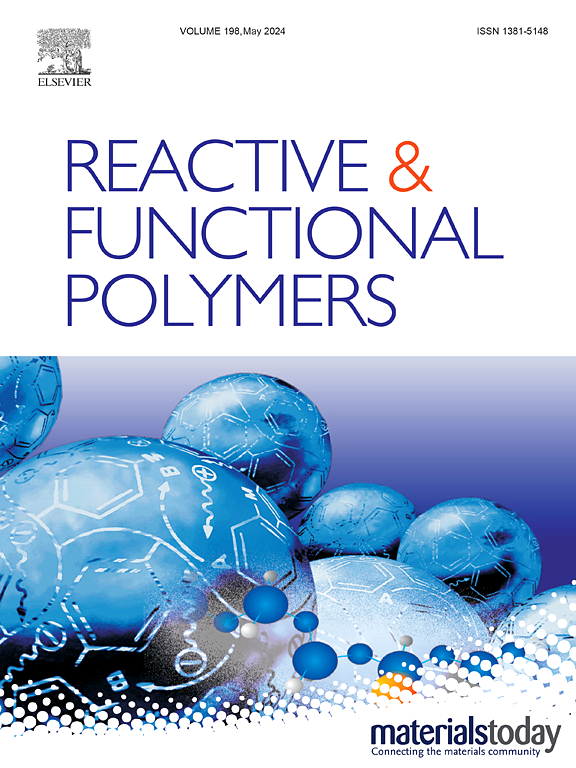Influence of thermal orientation on the dielectric properties of dendronised poly(2-oxazoline) hybrid membranes
IF 4.5
3区 工程技术
Q1 CHEMISTRY, APPLIED
引用次数: 0
Abstract
Dendronised poly(2-oxazoline) hybrid membranes were prepared by solution impregnation and phase inversion precipitation. Dielectric Thermal Analysis (DETA) was used to investigate the effect of the annealing temperature on the dielectric properties of these Side-Chain Liquid-Crystalline Polymers (SCLCPs). Independent of the different thermal treatments, the poly(2-oxazoline) hybrid membranes show similar dielectric spectra containing the same four relaxation mechanisms (γ-, αTg-, αClear-, and ρ-relaxation). The thermal orientation reduces the activation energy of the γ-relaxation, by modifying the steric hindrance of the associated aliphatic side chains. Aligning the polymer chains to each other, due to thermal annealing, leads to a less fragile structure. This reduced cooperativity decreases the temperature of the αTg-relaxation, related to the glass transition. The highly ordered structure of the oriented membranes increases the activation energy and temperature of the αClear-relaxation, associated with the freeing movement of the mesogenic side groups, especially in the homeotropically aligned membrane. The random orientation decreases the electron conductivity and its thermal activation, while the homeotropic alignment results in an increase, due to the orientation of the columns. The thermal orientation of SCLCPs leads to differences in the temperature dependence and cooperativity of the molecular relaxations and the conductive properties, providing valuable insights into their molecular structure and arrangement.

热取向对枝状聚(2-恶唑啉)杂化膜介电性能的影响
采用溶液浸渍和相反转沉淀法制备了枝状聚(2-恶唑啉)杂化膜。采用介电热分析(DETA)研究了退火温度对侧链液晶聚合物介电性能的影响。不同热处理条件下,聚(2-恶唑啉)杂化膜具有相似的介电光谱,包含相同的四种弛豫机制(γ-、αTg-、αClear-和ρ-弛豫)。热取向通过改变相关脂肪侧链的位阻,降低了γ-弛豫的活化能。由于热退火,聚合物链彼此对齐,导致结构不那么脆弱。这种降低的协同性降低了α tg弛豫温度,与玻璃化转变有关。取向膜的高度有序结构增加了α - clear -弛豫的活化能和温度,这与介生侧基的自由运动有关,特别是在同向异性排列的膜中。随机取向降低了电子电导率及其热活化,而各向同性取向由于柱的取向而导致电子电导率和热活化的增加。SCLCPs的热取向导致了分子弛豫和导电性能的温度依赖性和协同性的差异,为其分子结构和排列提供了有价值的见解。
本文章由计算机程序翻译,如有差异,请以英文原文为准。
求助全文
约1分钟内获得全文
求助全文
来源期刊

Reactive & Functional Polymers
工程技术-高分子科学
CiteScore
8.90
自引率
5.90%
发文量
259
审稿时长
27 days
期刊介绍:
Reactive & Functional Polymers provides a forum to disseminate original ideas, concepts and developments in the science and technology of polymers with functional groups, which impart specific chemical reactivity or physical, chemical, structural, biological, and pharmacological functionality. The scope covers organic polymers, acting for instance as reagents, catalysts, templates, ion-exchangers, selective sorbents, chelating or antimicrobial agents, drug carriers, sensors, membranes, and hydrogels. This also includes reactive cross-linkable prepolymers and high-performance thermosetting polymers, natural or degradable polymers, conducting polymers, and porous polymers.
Original research articles must contain thorough molecular and material characterization data on synthesis of the above polymers in combination with their applications. Applications include but are not limited to catalysis, water or effluent treatment, separations and recovery, electronics and information storage, energy conversion, encapsulation, or adhesion.
 求助内容:
求助内容: 应助结果提醒方式:
应助结果提醒方式:


